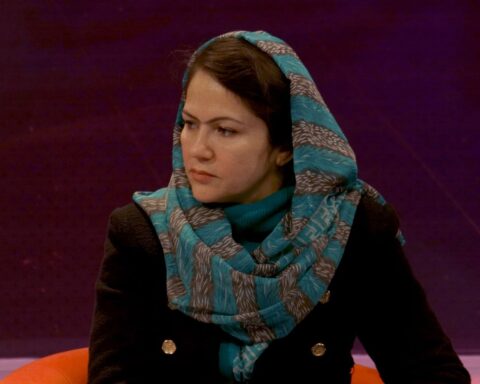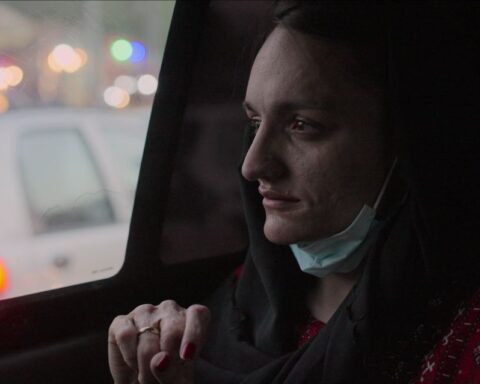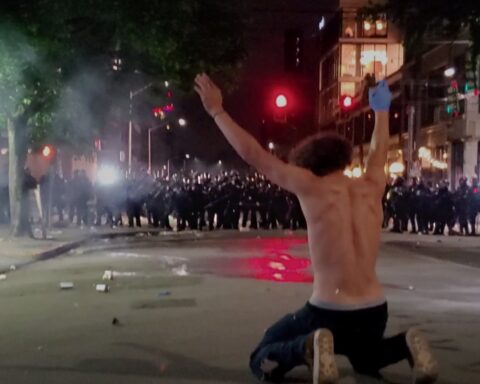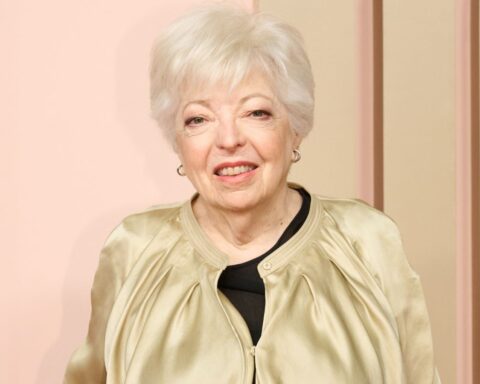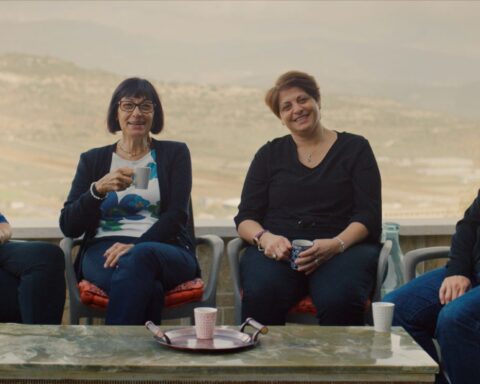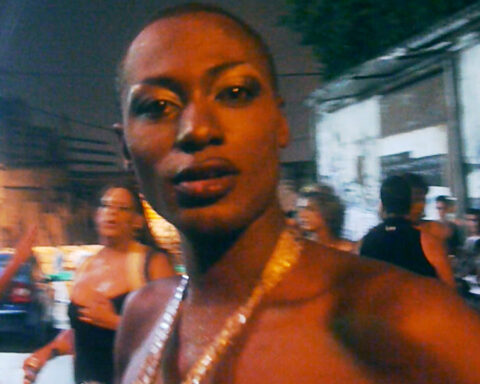Overhead screens show an exceptionally beautiful woman, a headscarf gathering with her hair in a brilliant desert landscape. Shot after shot of her, images dissolving, Afghan music being played but dulled by conversation in the full room at the Drake hotel. The spectacle makes it easy to forget this is a book launch, though the location gives it away: West Queen West, a key art scene corridor of colder than cool downtown Toronto.
The shots are of Nelofer Pazira, author of A Bed of Red Flowers, her memoir of Afghanistan. She starred in Mohsen Makhmalbaf’s hit art house feature Kandahar, based on Nelofer’s search for her “sister,” actually her best friend Dyana, inTaliban- controlled Afghanistan. It’s a quest she resumed in the documentary Return to Kandahar, which she co-directed with Paul Jay. Nelofer now lives in Toronto, but travels much of the time. Book tours, work as a TV correspondent, research for her feature-length drama, and a project on Armenia take her all over, from the high-beam limelight to the desperate middle-of-nowhere.
Nelofer’s sheer density of professional experience for a 32-year old is unique, as is her life experience growing up in a war zone and what she’s made of that. Internationally known directors, documentarians and TV crews have lensed episodes from her life. Like many attractive journalists—men and women—she has appeared in the foreground of TV news “stand ups,” often cleaved from a backdrop of frightening and disastrous images. Nelofer’s beauty and sophistication, her enthusiastic open style, are instruments she uses with consciousness and clarity to forge routes of access and to facilitate her ability to know and intervene in the world. Nelofer operates in, but can’t be reduced to, her celebrity status in the media. Her life and work are worth untangling.
A Bed of Red Flowers includes a description of an early childhood embroidered with sensuous contrasts: dust on velvet, bones tossed into a stream bordering Afghanistan and Soviet Russia. In these details, we get a feel for the poetic sensibilities of pre-Soviet Afghanistan’s privileged circles. Early ’70s Kabul was the “center of late hippiedom,” wrote Pakistani journalist Ahmed Rashid, its cheap hashish attracting east-seeking travelers to poetry and debates in the café scene circling the venerable University. Mid-decade, those times began to unravel.
The early chapters of her memoir sometimes strain at cross-purposes. Nelofer the journalist is determined to situate her story in an historical context but for outsiders Afghan politics are notoriously confusing. We are diverted to political intricacies from the more fascinating details of Nelofer’s teen years and her increasingly beleaguered family life in Soviet-occupied Kabul.
Zahir Shah’s regime resisted democratic reforms, eventually alienating the educated middle class; these political developments unfold alongside her father’s youthful perceptions as an idealistic physician in a remote rural town. The poverty and near-medieval traditionalism he encountered seeded his activism. He was soon to meet a beautiful privileged woman and marry her, convincing his bride’s reluctant parents that she would never cook or shop for groceries, a pledge he’s kept to this day.
Nelofer’s parents are interesting characters; they respond quite differently to war. Their personalities form a counterpoint that Nelofer triangulates. In A Bed of Red Flowers, we see through the eyes of a privileged and precocious teenage girl, an extrovert who thrives on challenges. Like the interviewer Oriana Fallaci whom she admires, Nelofer leverages her charisma to make the most of problems and opportunities. Both frequently come her way.
The civil strife that followed King Zahir Shah’s deposition by his cousin Mohammad Daud in 1973 drew in Nelofer’s father along with other intellectuals. Five years later the repressive Daud was assassinated in a military coup, and a pro- Moscow party put in power. Factional struggles culminated in the 1979 Soviet invasion and the replacement of one Communist leader by another. Intellectuals went into exile and young men were strong-armed into the Afghan army, creating job opportunities for women.
Nelofer and I spoke for a long afternoon in a café near the house she is renovating in Toronto’s east end. She told me, “The state was becoming more and more empty. The classic, well-known poetry reciters and anchors, writers and journalists, were fleeing the country. It created a space for people like me.” At thirteen, Nelofer hosted her own radio show. A librarian initiated her into the underground resistance, where she passed secret messages in books. Perhaps her reckless daring was inspired by her father, a patriot whose protests landed him in jail. His wife cajoled him to leave Afghanistan with the family, but he insisted on remaining. Every night around the table, Nelofer listened to their low-key but unmistakable quarreling. Again she took action, secretly securing false passports for the family’s escape.
High school was a dreary slog of Soviet-style curriculum, but Nelofer made fun of it and experimented with lovesickness and rebellion. I liked the edge in this chapter of the book, so we dwelt on it in our conversation. At night in her room, she devoured love stories and poems, transfixing other girls in the lunchroom with her summaries of the plots from romantic novels. On the “strip of freedom” walking home from school, they rolled up their skirts to reveal a little skin above their socks, sharing a clandestine pot of lip gloss. Nelofer’s sidekick Dyana worried her brother would catch them and report to her father.
Nelofer’s high school friendship with Dyana is a study in similarities and contrast. They both liked poetry, conversations about romance and Soviet- bashing. They shared would-be crushes on Mujahidin fighters. The foremost difference is the intellectual and emotional support Nelofer enjoyed from her father. Dyana was less politicized because she feared repercussions from her father, who Nelofer described as “not violent, but a very aggressive person. The family lived under his tyranny and fear. She always worried about him.” He contrasts with Dr. Pazira, a book-lover who enjoyed Parisian-style women, intellectually emancipated and elegantly groomed.
Life in Kabul gradually became untenable, wracked by unpredictable arrests and conscriptions and the gruesome fallout of Mujahidin rocket fire. More than 100,000 Soviet troops occupied Afghanistan between 1979 and 1989 until they were pummeled and finally rousted by Mujahidin “freedom fighters” armed to the teeth with billions of dollars in US support. More than a million of Afghanistan’s sixteen million died in what had become the leading Cold War theatre.
Early in the book, Nelofer described a bomb explosion at a bus station: an arm hanging from the destination board, a cart on its side, its hundreds of yellow and green prunes scattered on the road. She was sixteen at the time and one of the bystanders. “Tickets please. We act as if it’s perfectly normal to see men, women and children in pieces, quite natural to walk through their blood and body parts, then get on a bus for home.” Her friend Ibrahim, “a shy boy who didn’t talk much,” was killed. She did not attend his funeral: “I want to forget about those who die, not remember them. Otherwise my life is going to be dominated by dead people.”
Is Nelofer speaking with the psychic detachment teenagers feign to get on with life, especially in a war zone? Or is Nelofer the TV journalist, the film star and memoirist—in short, the adult—assessing her emotional past? Much of this book is written in the first person, present tense. It’s a grammar that can be confusing or perhaps intentionally ambiguous. There are split perspectives and rapid emotional dissolves as the word “I” shape-shifts from an analytical adult to the inner musings of a teenager and back.
Relentless missile attacks wore everyone out. “No Hollywood lighting expert could capture the paleness of my mother’s face, the quivering of her colourless lips when she hears the rocket fire.” Food was stockpiled and the Paziras were wealthy, but the rich were robbed and killed in broad daylight. Finally, Dr. Pazira succumbed to his wife’s entreaties and the family embarked on a dramatic and dangerous flight over the mountains to Pakistan. Her Mother rubbed “dirt makeup” on her hands as part of her disguise. “My Mother was raised with a standard of living and financial status. She went to a school with a connection to France. A lot of people were made into refugees and were changed. My mom went through it gracefully, without a scratch. It was very different for my Dad.” Her Mother’s European education, her style, self-composure and impeccable grooming and manners insulated her with upper middle-class transcontinental inviolability. “She always presents herself as ladylike, even in her pajamas. The shimmer, the colours—she won’t go shopping without jewelry. She doesn’t cook. She spends her time between clothes stores and furniture stores. She has no patience or interest in grocery shopping. My father does it.” In all her work, Nelofer insists such a division of labour is not simply a luxury of privilege, European education or western secularity. It is a right.
Whenever I see Nelofer, in person or in films, she wears turquoise drop earrings that ignite the green of her eyes. So I asked her about them. Nelofer’s family arrived as refugees in Canada just before her seventeenth birthday. Immigration advised them to bring only ten dollars per person. Sympathizers offered a few hand-me- down chairs, a table and towels. The stones are among the few things her father brought to Canada. Nelofer told me, “He must have found cheap earrings at a garage sale, and remade them for my birthday gift. That’s why they’re so precious. Even when you get to the absolute bottom level of poverty, you can always use your imagination.”
In Canada, Nelofer drew on her reserves of self-discipline, curiosity and focus to learn English and obtain degrees at Carleton in journalism and English Literature, throwing herself into “all things west. My thesis work combined anthropology, sociology and religion. I’d carved this out because of the specific subject I wanted to study, refugee women.” Throughout her studies, she told me, “the centre was Afghanistan, not Canada. A lot of us have to deal with this issue of what is home; otherwise we live with the theme of wanting to return or recreate what we left here in Canada. For me, that’s very dangerous because you begin to idealize your idea of that past. You don’t acknowledge that human societies are in flux, they change, nothing remains the same at all, anywhere.”
She got along better with politicized second-generation Muslims than with new arrivals from Syria, Lebanon, Senegal and Egypt. “I held the position that I had the right to use the name Muslim as much as they did, and they got quite upset.” So she co-founded a Second Generation Muslim Discussion Group. “We discussed feminism and Islam, homosexuality and Islam, democracy—things that are considered untouchable. In a way, that marked my transition to this society, though I still wanted to study and make something of myself and go back.”
The last Soviet troops left Afghanistan in 1989, but the civil war continued, turning Kabul into a death zone and driving tens of thousands to refugee camps. Nelofer was first disillusioned with the Mujahidin shortly after her arrival as a refugee in Pakistan. She expected to be welcomed as a resistance fighter; instead, militants shot at her, when she left her house without a head covering. Afghans trained in Pakistan’s religious schools founded the Taliban with former Mujahidin fighters. The Taliban, or youth militia of “God’s Students” led by Mullah Omar, made a remarkable advance, taking Kabul in 1996. Traditional Islamic rule had appeal for a war-torn people sick of lawlessness and infighting. But their strictures utterly changed the Kabul that Nelofer had known.
Dyana’s accounts in her letters of war and the restrictions on women’s freedom under the Taliban became increasingly terrifying. Dyana’s story provides a parallel between the domestic patriarchal family and the state under Taliban rule. Her father became her warden. Trapped, she pleaded with Nelofer to find her a husband in Canada, marriage being the only exit strategy acceptable to her parents. Finally, Dyana revealed her depression and wish to commit suicide. Nelofer told me, “In March of ’98 when I received her letter I was convinced something was wrong. I wanted to leave and go. There are times when one has these impulses that are almost irrational. Maybe later one can try to rationalize and explain, but at the time it is an impulse that one has to do something.” As storytelling goes, her rescue mission has postmodern twists: a quest deep into dangerous territory to free a captive woman before she perishes, with the active agent a woman from that territory, disguised by a veil. The narrative is the seed for the fictional feature Kandahar, the documentary Return to Kandahar and the book A Bed of Red Flowers.
Nelofer began her search for Dyana in Tehran. At the Pakistani embassy, she was “treated like furniture.” Her friends suggested the renowned Iranian filmmaker Mohsen Makhmalbaf might help her, so she called him. She described the beginning of their friendship to me. “At first he said, ‘I don’t do interviews with foreign reporters.’ I said, ‘I don’t want an interview, I want to talk with you about an issue.’ He said, ‘You have ten minutes. If you want to come to my office, here’s the address.’ I went, and after two hours he was still talking. He said, ‘I’ve never met an Afghan woman.’ Three million Afghanis live in Iran and he was asking me, ‘What do Afghan women wear? What music do they listen to?’ Very basic questions. I said, ‘You know what? If you’re so interested, why don’t you get your camera and come with me?’” His other obligations made this impossible.
Nelofer returned to Canada, fearing Dyana was dead. She kept working on her graduate thesis and followed up with Makhmalbaf, sending him letters and music, sharing her vantage point and cultivating his engagement with Afghanistan. Over a year later, Makhmalbaf called. “He said, ‘I want to make a film and I can’t do it without your help. You have to come as soon as you can.’ I was thinking, I have a meeting with my thesis supervisor…’” Not surprisingly, she dropped her thesis and left to work with the famous director.
Makhmalbaf certainly did need Nelofer. His feature Kandahar not only stars her but is based on Nelofer’s brief attempt to enter Afghanistan under Taliban rule to find Dyana—the mission which Makhmalbaf had been unable to help her. In the film, Nelofer disguises her newly- minted identity as a western journalist by donning a burqa and posing as her guide’s fourth wife for the foray into the rural Afghan desert, toward Kandahar. Makhmalbaf’s camera pivots on Nelofer’s extraordinary beauty in the brilliant desert light. Veiled and unveiled from the burqa she wears as a disguise, Nelofer is less a character than a statue of liberty, a personification of the enduring spirit of Afghan women. These are the images projected at her book launch at the Drake.
There are contrasts in the film that bring to mind her mother’s “dirt makeup.” Nelofer’s luminousness abuts finely- etched details of desperation. The contrast borders on dreamlike. For example, Nelofer visits a UN infirmary—a few tents where desperate landmine victims gather to plead for false limbs. On hearing an overhead plane, they rush in its direction as its cargo of prosthetic legs falls from the sky on tiny parachutes.
Mohsen Makhmalbaf shot Kandahar in an Afghan refugee camp in Iran; most who perform in the film are refugees. Nelofer told me, “People don’t know if they’re stuck there for another month, another two years, or for life. Looking from outside, it’s absolutely painful. That’s my Canadian side—to want to fix things, and a feeling of utter helplessness because there are no easy fixes.” Sometimes the locals worked with the filmmakers and at other times, they withdrew. There were daily script changes and footage scrapped when women backed away or were blocked from showing up. The filmmakers set up a makeshift cinema that delighted children, until adult infighting forced them to shut it down.
Nelofer struggled with her own desire to solve the situation. Looking back at the Afghans she met while filming, she said, “is like looking at the beginning of humanity, in a way. We can’t stand our own past because we find it too primitive and deprived. I used to be very frustrated, but I’d ask myself, ‘what do I want to change and why? Is it something they want, or something I want to bring to them?’” She’s quick to distinguish this line of questioning from those who say, “‘it’s part of their culture. They’ve always been like that’. I get angry at these comments because they’re ignorant. No society is uniform. There is always change and movement, but it is easy to think that in a conflicted part of the world, everything else is stagnant.”
Kandahar captures unforgettable details, a magic realism of extremes, and the stress of making the film shows. Storytelling and acting are choppy. We sense Makhmalbaf’s reliance on Nelofer, their tensions working with non-actor refugees, and the absence of conclusion to the Dyana story. The film’s ending is confusing and abrupt. Honest in its complexity, Kandahar might have played as a small but admirable art movie after Nelofer and Makhmalbaf launched it at Cannes in May 2001. But the cataclysmic events of 9/11 rocketed Kandahar to international attention in a world suddenly hungry for details about Afghanistan.
Again, circumstances provided Nelofer with extraordinary opportunities, compelling her to learn on her feet. She told me, “The strangest thing in my life, another contradiction and extreme, is during the years in Afghanistan and in Moncton, I’d never gone on stage or done any acting, even in a little play. The only course I never took was film studies. English literature introduced me to terminology and trends, but I never learned the analytical tools or history of the development of film in the west. All of a sudden I was parachuted into the film world and had a tough time to catch up.” She found herself on juries at the Locarno Film Festival, in Sao Paulo, in Montreal and Geneva. “I was the youngest member of these juries and sometimes the only woman as well, judging with older filmmakers and producers who had grown up all their lives to be part of that world. That in itself was an education for me, though I lost my privacy. I’m now so much a part of that world that I don’t think I can live outside of it.”
Still, she immediately said to herself, “this is all a bubble. I felt my mission was to get attention for Afghanistan. I arrived in Italy, in Spain, in Japan, to full press conferences, cameras, and they were all interested. For years in Moncton and Ottawa, things were completely bottled up for me in terms of Afghanistan and what I saw there.” In the international spotlight, she described to me how, after a panel in Italy, she was quoted in headlines in Spain: “Nelofer Pazira says George Bush and Bin Laden are the Same.” She explained to me, “In fact, I said in terms of their mentality, they have a much closer meeting point than the rest of us, in their vocabulary and use of religion. But I was bombarded in Spain with outrage that I made this statement. Of course, it was October 2001. They were just starting to bomb Afghanistan. My point is, it takes a lot for people to stand in the middle and resist.”
Nelofer and Paul Jay’s documentary Return to Kandahar is a deglamourized, more on-the-ground view of her Dyana search. Here she resumed her hunt for Dyana in post-Taliban Afghanistan. A journalist and celebrity, she was frequently regarded as a western outsider. In a key scene, Nelofer fearlessly dresses down a group of male students who object to her interviewing women who returned to University after the Taliban’s fall. Her angry eloquence sparks applause and shrieks of “go girl!” from audiences. Everyone is riveted: what happens to Dyana? Will Nelofer rescue her? As the doc unfolds, Nelofer seems drawn in by shady informants who claim to have contacts with Dyana’s family. We join Nelofer in following the leads. Finally, a letter read in voice-over from her uncle says what Nelofer sensed before working on Kandahar — Dyana had committed suicide. Return to Kandahar reads like the ending that Kandahar could only suggest. Nelofer has since founded the Dyana Afghan Women’s Fund to provide educational opportunities for women in Kandahar. To fundraise, she enlisted her sister, an innovative fashion designer, and her colleagues at the CBC.
After decades of war, Afghanistan is littered with unexploded ordinance; it is the most heavily land-mined country in the world. One of Nelofer’s documentaries for CBC’s The National focuses on cluster bombs. While filming Return to Kandahar, she met Afghans who do the deadly work of defusing explosives and was moved by their spiritual insights. She saw a story and stayed on, shooting by herself, and then securing a cameraman. This television documentary for CBC is Nelofer’s best work. Her personality and experience are included, but so is her empathetic ability to see and draw stories out from others.
Her CBC producer for this project, Geraldine Connelly, describes Nelofer as “extremely photogenic, very good on camera and with people. She draws response from those she interviews and from viewers. She’s also feisty and knows her own mind, where she’ll compromise on something and where she won’t.”
At times at The National, Nelofer says, “I feel I live in the Afghanistan box. In spite of my relationship with that country and what I feel about it, I would like to live outside of that box. It is not surprising that I’m asked to do stories on Muslim topics, in part because I have a long relation with the Muslim community in North America. The fact is, I can see it is easy for them to say, ‘I’ve got someone from that part of the world with an accent,’ to cover up for whatever else is missing from the network.”
She is driven to push boundaries, telling me, “When it comes to the Muslim community, I drive them crazy. I push and I push and I push. At the same time, it is important to challenge one’s self and that comes from challenging rules and regulations. Especially social norms, because we think social norms are a product of what creates order in our societies, but norms and order are not always appropriate for the times that are changing. Working for the CBC, promoting my book, writing —I always have to push the envelope. I’m in a privileged position and if I opt for comfort, put my head down, get my paycheque and go home, then why would I expect anyone else not to?” This sense of noblese oblige blends her father’s and mother’s influences.
Nelofer has European art film flair, revealed in The Giant Buddhas, a Swiss documentary by Christian Frei. The voice- over, in belle-lettres style, is addressed to “Dear Nelofer,” repeated through the film’s account of the looting and neglect of Afghanistan’s people and rich archeology. We follow Nelofer on a return journey to see where the Buddhas were photographed with her father. She stands in front of their gaping absence. The film climaxes with a stunning 3D graphic recreation of the Buddhas, as a kind of gift to Nelofer. As in Kandahar, Nelofer appears alongside Afghanistan’s physical, virtual and remembered geographies.
Nelofer tells me her brother was skeptical about her gear-shifts between television, features, writing and documentaries. Her response can be taken as a credo: “Life is in a constant state of flux and change. That’s what I like about films and journalism; I consider them empty structures. I know my own nature and I like this ability to move between mediums and methods, strategies and topics. I don’t like borders and boxes. I like to mix and match as much as I can.” Call it a documentary fashion sensibility, or a drive to explore different narrative containers. Geraldine Connelly notes, “Nelofer has a remarkable drive to learn things, to improve her skills or adjust to a format, as long as it doesn’t fundamentally alter what she’s trying to say.” These skills suit contemporary technologies. Connelly adds, “Overall, people tend to make a fuss of her for the wrong thing—because she’s very beautiful, she’s been to Cannes and all over the world—but you know, it’s her character that is quite the thing, just who she is as a person.”
I asked Nelofer if she’ll move back to participate in the post-Taliban government under Hamid Karzai, with its high proportion of returning exiles. She said “I’m faced with this question all the time: ‘are you going to pack and go back?’ There are possibilities: Minister of this and that, major positions. But I don’t want to be involved in politics. I prefer the hat of artist or journalist if I can claim it. At the same time, I feel it doesn’t matter what part of the world I physically live in; it matters where I can be most effective, to bring communities together as opposed to driving them apart.”
Nelofer has a friend whose family came from Bangladesh. He was born and raised in Saskatchewan. He complained that the media description of post 9/11 New York as a mini war-zone didn’t bring it home for him, because he doesn’t know what a war zone is like. Nelofer replied, “”Fortunately for you, you don’t.’ In a way, I’m happy the concept is so foreign for a lot of people. Nobody should live in those places of uncertainty, torture and war. On the other hand, it says a lot about the gap between our perceptions. I can talk about these things as my first-hand experience. If I bring even a tiny glimpse of the world of a woman like myself to someone who’s curious, then my role is much greater and I’ve fulfilled something more important to me than living in a cozy air-conditioned apartment in Kabul with a driver and a car. A lot of people will go back with financial means and live like that.”
In her best work, Nelofer Pazira catches the spotlight with her charisma and experience and then deflects it onto others, weaving their events with hers to reveal how war erodes civic consensus. Time and place are shattered by rocket fire, but also by desperation, occupation and exile. As the semblance of time marching forward through a coherent world is shredded, contradictions and paradoxes emerge. With them, come new debates and opportunities for compassion. Nelofer may well be a figure in the forefront of a meshed and worn global fabric, representing versions of possible change.




